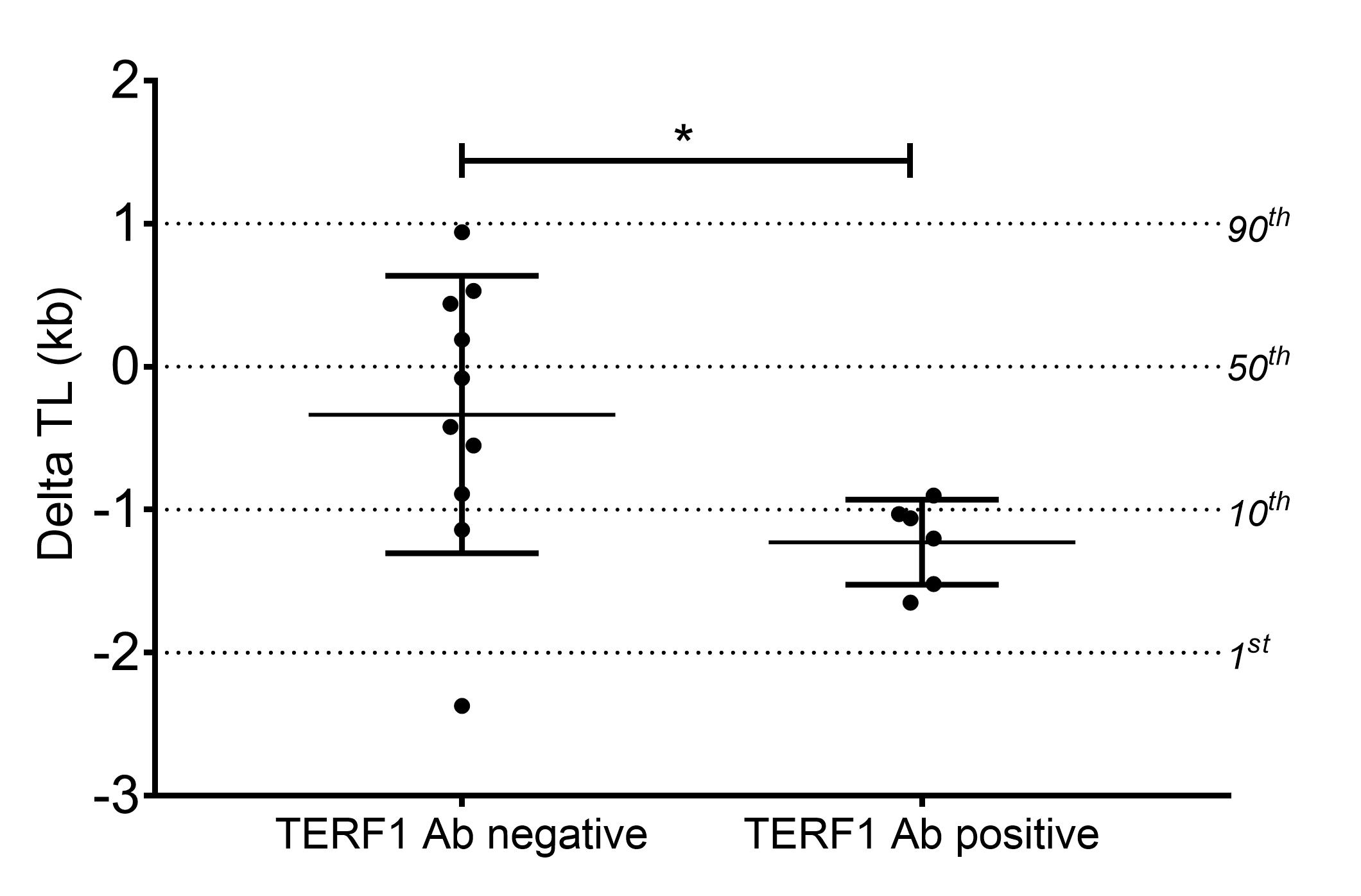Session Information
Date: Monday, November 9, 2020
Session Type: Abstract Session
Session Time: 4:00PM-4:50PM
Background/Purpose: Scleroderma is a systemic fibrosing disease of unknown etiology that often manifests with interstitial lung disease (ILD). Prior studies have found an association between telomere shortening in lymphocytes and scleroderma-ILD, but the mechanisms underlying this association are unclear. Because autoantibodies strongly predict clinical phenotype in scleroderma, we investigated whether patients with scleroderma and short telomeres have autoantibodies targeting telomerase (hTERT) and the shelterin complex which protects telomeres.
Methods: We screened patient sera from two separate longitudinal scleroderma cohorts from Johns Hopkins (JH, n=200) and the University of California, San Francisco (UCSF, n=242) for autoantibodies targeting hTERT and the six shelterin proteins TERF1, TERF2, POT1, TPP1, TIN2L, and RAP1. ELISA and immunoprecipitation assays were used for autoantibody detection. Peripheral leukocyte telomere length was measured in all patients from the UCSF Cohort using qPCR, and telomere length was measured in lymphocytes and granulocytes from a subset of the JH Cohort (n=16) using Flow Cytometry and Fluorescent in-situ Hybridization (Flow-FISH). To determine if telomere-associated autoantibodies are present in other diseases for which telomere dysfunction and lung fibrosis are prominent features, we screened a cohort of 153 UCSF patients with idiopathic pulmonary fibrosis (IPF) for autoantibodies targeting telomere-associated proteins.
Results: We identified a subset of scleroderma patients with multiple autoantibodies targeting hTERT and the six shelterin proteins, of which TERF1 autoantibodies were the most common. TERF1 autoantibodies were detected by ELISA in 22/200 (11%) of the JH Cohort and 18/242 (7%) of the UCSF Cohort, and were rarely present in patients with rheumatoid arthritis (1/50) or dermatomyositis (1/50). TERF1 autoantibodies were associated with shorter telomere lengths in both the JH and UCSF Cohorts. Compared to scleroderma patients without TERF1 autoantibodies, a greater frequency of UCSF scleroderma patients with TERF1 autoantibodies had a shorter telomere length in leukocytes than the expected age-adjusted telomere length (78% vs 43%, Fisher’s exact test, p=0.006). Similarly, JH scleroderma patients with TERF1 autoantibodies had a shorter age-adjusted telomere length in lymphocytes (-1.2 ± 0.3 vs -0.3 ± 1.0 kb, p=0.02, student’s t-test). When the JH and UCSF Scleroderma Cohorts were combined, TERF1 autoantibodies were associated with a history of severe lung disease (OR 2.0, p=0.03, chi-square) and the presence of Ku (OR 5.4, p=0.02, chi-square) and U1RNP autoantibodies (OR 4.8, p=0.0006, chi-square). We further identified TERF1 autoantibodies in 12/153 (8%) of patients with IPF.
Conclusion: We have identified novel autoantibodies targeting multiple telomere-associated proteins in scleroderma and IPF, which are associated with short telomere length in peripheral lymphocytes and severe lung disease. Autoantibodies targeting telomere-associated proteins may have utility in the diagnosis and subtyping of scleroderma and may provide novel insights into the role of telomere dysfunction in scleroderma and other fibrotic lung diseases.
 TERF1 autoantibodies detected by ELISA in healthy controls (n=78), the Hopkins Scleroderma cohort (n=200), the University of California, San Francisco Scleroderma Cohort (n=242), rheumatoid arthritis (n=50), and dermatomyositis (n=50). Chi-square test was used for to compare the frequency of TERF1 autoantibodies between different cohorts. * p < 0.05, **p < 0.01.
TERF1 autoantibodies detected by ELISA in healthy controls (n=78), the Hopkins Scleroderma cohort (n=200), the University of California, San Francisco Scleroderma Cohort (n=242), rheumatoid arthritis (n=50), and dermatomyositis (n=50). Chi-square test was used for to compare the frequency of TERF1 autoantibodies between different cohorts. * p < 0.05, **p < 0.01.
 Telomere length measured by FlowFISH in lymphocytes of 6 TERF1 autoantibody positive scleroderma patients and 10 TERF1 autoantibody negative scleroderma patients. Patients with TERF1 autoantibodies have shorter telomere lengths in lymphocytes compared to TERF1 autoantibody negative patients. Delta TL is the difference between the patient telomere length and the median telomere length of a healthy control population. Statistics were done with the Wilcoxon rank sum, * p < 0.05.
Telomere length measured by FlowFISH in lymphocytes of 6 TERF1 autoantibody positive scleroderma patients and 10 TERF1 autoantibody negative scleroderma patients. Patients with TERF1 autoantibodies have shorter telomere lengths in lymphocytes compared to TERF1 autoantibody negative patients. Delta TL is the difference between the patient telomere length and the median telomere length of a healthy control population. Statistics were done with the Wilcoxon rank sum, * p < 0.05.
 Peripheral blood leukocyte telomere length measured by qtPCR in 242 scleroderma patients from the University of California, San Francisco Scleroderma Center. A) Relationship between leukocyte telomere length and age for TERF1 autoantibody positive (n=18) and negative (n=224) patients. B) Patients with TERF1 autoantibodies have a greater difference between the expected age-adjusted telomere length and their actual telomere length compared to TERF1 autoantibody-negative patients. Statistics done using Wilcoxon Rank Sum, * p < 0.05.
Peripheral blood leukocyte telomere length measured by qtPCR in 242 scleroderma patients from the University of California, San Francisco Scleroderma Center. A) Relationship between leukocyte telomere length and age for TERF1 autoantibody positive (n=18) and negative (n=224) patients. B) Patients with TERF1 autoantibodies have a greater difference between the expected age-adjusted telomere length and their actual telomere length compared to TERF1 autoantibody-negative patients. Statistics done using Wilcoxon Rank Sum, * p < 0.05.
To cite this abstract in AMA style:
Adler B, Shah A, Boin F, Wolters P, Casciola-Rosen L, Rosen A. Short Telomeres and Autoantibodies Targeting Telomere-Associated Proteins in Scleroderma [abstract]. Arthritis Rheumatol. 2020; 72 (suppl 10). https://acrabstracts.org/abstract/short-telomeres-and-autoantibodies-targeting-telomere-associated-proteins-in-scleroderma/. Accessed .« Back to ACR Convergence 2020
ACR Meeting Abstracts - https://acrabstracts.org/abstract/short-telomeres-and-autoantibodies-targeting-telomere-associated-proteins-in-scleroderma/
